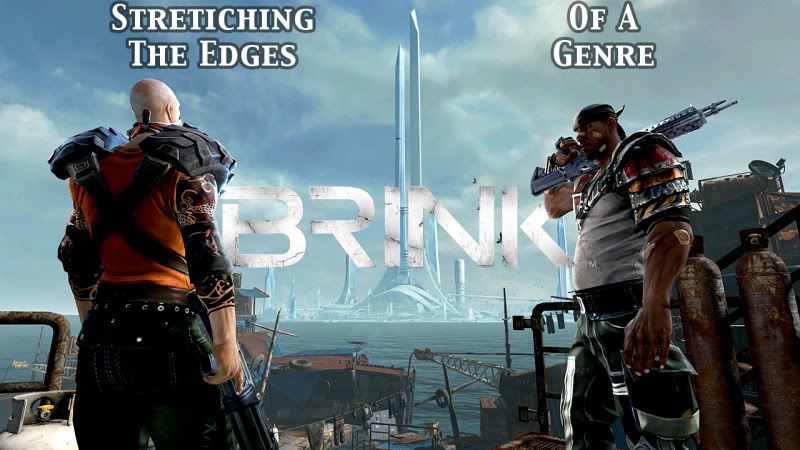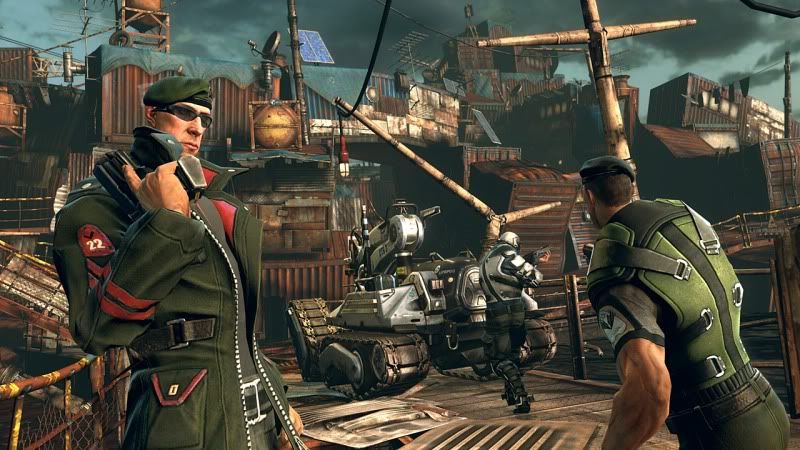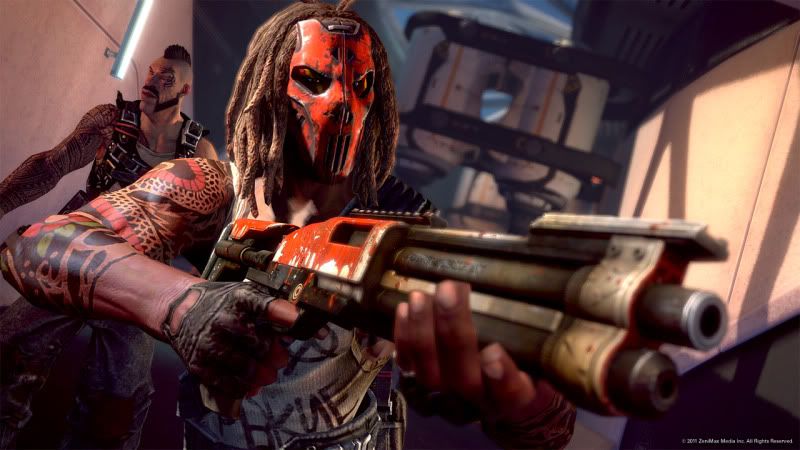REVIEW: The Brink of a Genre, Worth Exploring
|
Brink was developed by Splash Damage and published by Bethesda Softworks for the Xbox 360, PlayStation 3 and Windows PC. It was directed by Paul Wedgewood, Richard Ham, Olivier Leonardi, Chris Sweetman, Arnout van Meer, Richard Jolly and Stephen Gaffney. The Xbox360 copy was played for the purpose of this review following the day one patch released from developer Splash Damage. Innovation rarely produces perfection, but it always brings something new to the table. Something on the brink of existing standards, stretching old rules with the new ideas it brings forward. Flipping on Brink for the first time, and watching it’s lengthy tutorial videos (10-30 minutes), you get the immediate sense that you are playing an ambitious shooter. Four classes, directly interdependent with one another, three distinct body types, and a plethora of weapons and abilities help shape the battlefield of Brink in a way that is rarely seen in this generation’s run ‘n’ gun, lone-wolf brand of first-person shooters. Brink’s team centric, objective-based battles are laden with a variety of fun opportunities, but they are also fraught with technical issues that will leave those with slow internet connections as well as eye-candy junkies disappointed. Visual issues frequently result in constant texture pop-in and online lag often interrupts the fast-paced flow of combat. Problems with the bot’s artificial intelligence in Brink can also be downright infuriating. There, is without a doubt, mountains of lasting fun to be had with Brink, however with all it’s innovation aside, it falls short of perfection.
The Brink experience commences with a choice, a dramatic one at that. Will you choose to enforce the law and security of The Ark, which may be the last floating safe haven for humanity in a post apocalyptic world? Or, will you fight for freedom from the oppressive police of this solitary island, and seek the help of the other survivors that must be out there? While the choice seems important at first, it quickly becomes insignificant. Character stats and abilities remain persistent regardless of the faction you choose to fight for, what’s more, you’re free to play through both stories in any order you prefer. In fact the only true difference in your choice is the default colour scheme of the menus, and the standard appearance of your character that is displayed at all times when not in-game. This lack of weight to your decision is far from a bad thing. Brink’s story does an excellent job of showcasing the grey-area in any war, let alone a civil one between citizens co-existing in close proximity for years. The brunt of Brink’s story is delivered in pre-match voice overs during loading screens, and pre/post match cutscenes. The cutscenes are different for each faction, effectively telling the story of each side.These brief snippets of context (30 seconds to a minute each) feature well written dialogue between three of your nameless comrades, that still manages to draw you into their lives, giving you a tangible reason to fight. Mid-match cutscenes as well as in-game vocal commands from your faction specific mission commander, help to bring context to the in-game activities of the often lengthy matches. (two evenly matched teams could potentially duke it out for over and our in one match!) As you level up your character, you will unlock audio logs. These audio logs offer large amounts interesting back stories of the citizens of The Ark and your mission commanders. While it’s unfortunate that these expertly well-voiced diaries are relegated to a menu within Brink’s dossier, the unlock rate is well spaced out, giving you a steady supply as you level-up, encouraging you to return and listen. With over 90 minutes of engaging logs to listen to, it becomes very clear that there is no shortage of complexity to the story of The Ark’s people.
Brink’s online integration means that with the exception of the four Challenge maps, every match you play takes place on one of eight maps featured in the campaign. The order of the maps is worth noting, with some maps only occurring as What-if maps that deal with alternate story routes different to each faction. The way these standard maps and What-ifs are pieced together is at first confusing to behold, but rewarding once you’ve played through both faction’s story and everything clicks. When you start up a match, you can determine what map you play, who can join your game (if anyone), which player ranks are allowed, and whether or not human players are allowed on the enemy team. Setting up a game in freeplay mode enables more customization options, from team size, to friendly fire, public voip and more. Before you get into a match you have the option to watch extensive tutorial videos that familiarize you with the very busy and complex battlefields of Brink. Though they may feel like they’re dragging on for a while to a veteran class-based shooter fan, they are full of good information that can help you get your bearings, whether you are new to objective-focused, class-based combat or not. Brink’s stylish character customization suite offers a large array of options. After choosing from an all-male selection of archetypal faces, voices, and tattoos/scars, you equip yourself with either the clean-cut, well maintained look of the security forces, or the disheveled motley look of the resistance. You unlock a ton of new faction-specific clothing, hairstyles, face paint, and gear as you level up, and to say it’s fun to play around with your character’s look as you progress would be an understatement. The only feature of character creation that actually changes how you play the game is your body type. The medium body type is the only one initially available, with heavy and light body types unlocking as you level up. Heavy body types have the most health and can carry the most powerful weapons, however they have the slowest movement speed, and their athletic ability pales in comparison to the medium or the light. This makes them ideal for taking out large groups of enemies even if you’ll often find getting around a chore. Light body types can carry only SMGs and pistols, and they have the least health, but they’re also the fastest and most athletic. They make the most out of Brink’s S.M.A.R.T. (smooth movement across random terrain) movement system, allowing them to leap over and around map obstacles with speed and grace. The medium body type is a happy medium between the other two offering a pleasant blend of the other two’s pros and cons. Offering varying styles of movement is one of Brink’s many innovations, it succeeds with flying colours! Orchestrating a swift escape or a bold sabotage with a light character delivers a big rush of adrenaline, while mowing down the whole team’s squad as a heavy is nothing short of satisfying. All characters can sprint, slide, and jump with scaling level of efficiency, and this mobility keeps you on your toes and helps combat stay fresh. Perform a slide-tackle on an enemy, and you’ll topple them over resulting in tense close quarters moments that’s a great blend of melee attacks and gunplay. Holding down the S.M.A.R.T./sprint button while running into an object results in your character vaulting over it, sliding underneath, or mantling on top (body type permitting). Manually using the jump/climb, crouch/slide and sprint buttons while aiming your camera correctly results in movements that are much smoother and efficient. During all this free running goodness, you’re always in complete control of your weapon, allowing to rethink your evasive maneuvers and transform them into a new style of attack. Many class specific abilities can also be performed during these fast movements.
Brink’s class system is well executed, offering a variety of ways to contribute to the fight. The differences between the classes are sculpted by unique abilities that you gain access to as you level up. Soldiers focus on doing damage with grenades and other high explosives while keeping teammates ammo supply at acceptable standards. Medics have a variety of different buffs that make teammates faster and tougher to kill. They can also revive downed teammates on the field. Engineers can place mines and sentry turrets as well as offer their teammates’ weapons a damage boost. Operatives can disguise themselves as enemies, gain intel from incapacitated enemies and spot threats on the battle field. With 10 or 11 abilities specific to each class, as well as another set of 10 universal abilities, there is a ton of room for creating a character specific to your play style. Unlocking a new ability to use and devising new strategies to use in battle is empowering. Most abilities drastically alter your play experience, making it fun to experiment and create new characters once you’ve hit the level cap of 20. When all your teammates are on the same page, and playing to their strengths, battles are always intense. A useful objective wheel helps you keep track of how you can best contribute to the team. Many objectives are class specific, however you’re never locked into one class. You can change your class as well as weapons mid match at any friendly command post. Each team has one command post in their spawn area, however capturing, upgrading, and fire-walling command post closer to the action gives your entire team a bonus both in stats and in strategic class change opportunities. The scope of these side battles around command post and other tertiary objectives is, understandably, scaled down from those around the primary objectives. The intensity however, never declines. It was within these smaller skirmishes that I found my heart beat begin to pick up, the VOIP chat volume begin to increase amongst my teammates, and the victories to be that much sweeter. Brink excels when matches are populated by a group of other human players and you’ve got a zippy internet connection. If you find yourself competing with a slow internet connection you’ll find multiple instances of jerky lag rendering the match unplayable and forcing you to quit and try again until you find a session where the other players can host the connection. Sessions with a dearth of human players can also be quite irritating, because artificial intelligence is by far Brink’s weakest point. A.I. bots run the gamut from ruthless killers to retarded fools. You may find yourself saved by a particularly effective bot running into a room gunning down three enemies and then reviving you, or you may find yourself spectating other bots while waiting for a respawn only to see them standing still doing nothing, far away from any point of interest, begging the question where was my support when I just died! Online matches usually have enough human players to limit these unfortunate occurrences however, the shortcoming of Brink’s A.I. certainly limits the window of enjoyment to online only.
The only gameplay modes in Brink aside from the objective maps, are four Challenges for you to complete in exchange for a leader board position, new weapons, and gun attachments. Altering your loadout with these unlocks is extremely satisfying. In fact, you can use that word to summarize the entire experience that is Brink. From the innovative movement system, to the stylized art style, or the intricate class execution, a foray into the war over The Ark is an immensely satisfying one offering several hours of replayability, even if not perfect. Emotional Addendum |



